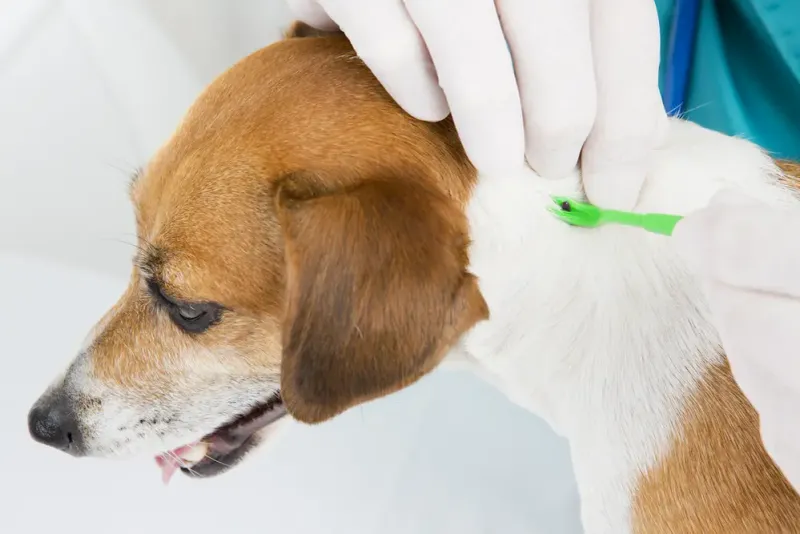Vets Reveal The Most Common Signs Of Lyme Disease In Dogs

Lyme disease is a serious tick-borne illness that affects thousands of dogs each year. When caught early, treatment can be highly effective, but many pet owners miss the subtle warning signs.
Veterinarians have identified key symptoms that every dog parent should watch for, especially if you live in wooded areas or regions where ticks are common.
Lameness Or Limping

Your normally active pup suddenly favors one leg, then maybe switches to another a few days later. This mysterious, shifting lameness is a hallmark of Lyme disease.
The bacteria attacks joint tissues, causing inflammation and pain that makes walking difficult. Unlike injury-related limping, Lyme-induced lameness often comes and goes or shifts between different legs.
Swollen Joints

Feel around your dog’s knees, elbows, or other joints. Warm, puffy joints that seem tender to touch might signal Lyme disease at work.
The Borrelia bacteria causes inflammation inside joint capsules, leading to fluid buildup and swelling. These hot, painful joints often accompany the characteristic shifting lameness and can affect multiple limbs simultaneously.
Fever

A warm nose and ears might be more than just normal dog warmth. Lyme disease frequently triggers fever as your dog’s immune system battles the infection.
Normal canine temperature ranges from 101-102.5°F, but infected dogs may run 103-105°F. This elevated temperature often comes alongside lethargy and decreased appetite, creating a generally unwell appearance.
Loss Of Appetite

That full bowl of kibble sitting untouched? When your food-motivated companion suddenly turns away from meals, something’s definitely wrong.
Systemic inflammation from Lyme disease affects appetite centers in the brain. Joint pain also makes the simple act of walking to the food bowl uncomfortable, creating reluctance to eat even favorite treats.
Fatigue Or Lethargy

Remember your ball-crazy retriever who never stopped moving? Suddenly she’s sleeping all day and ignoring play invitations. Fighting infection drains energy as the immune system diverts resources to battle bacteria.
Joint pain further discourages movement, creating a downward spiral of inactivity. Many owners mistake this dramatic energy decrease for normal aging.
Difficulty Breathing Or Shortness Of Breath

Rapid, shallow breathing in a resting dog should raise immediate concerns. While less common than joint symptoms, respiratory changes signal advanced Lyme disease.
The infection can spread to heart tissue, causing inflammation that affects cardiac function. This heart involvement leads to decreased oxygen circulation, forcing your dog to breathe harder even during rest periods.
Excessive Thirst Or Urination

Suddenly refilling the water bowl three times daily? Lyme disease can attack your dog’s kidneys, triggering increased drinking and urination. Lyme nephritis damages kidney filtering systems, causing protein leakage and electrolyte imbalances.
This kidney involvement represents a serious complication requiring immediate veterinary attention, as damage can become permanent without prompt treatment.
Tenderness Or Sensitivity To Touch

A yelp when you pet your normally cuddle-loving companion signals pain. Dogs with Lyme disease often develop generalized sensitivity, especially around joints and muscles. Widespread inflammation creates tender spots that hurt when touched.
Your dog might snap or move away during petting sessions or resist being picked up. This behavior change often confuses owners who don’t connect it to possible infection.
Red Or Inflamed Skin

Unlike humans, dogs rarely develop the classic bullseye rash. However, some show redness or irritation at the tick bite site. Check areas where ticks commonly attach: ears, neck, armpits, and groin.
The inflammation might appear as a small red spot with slight swelling. Many owners never notice this symptom since it’s often hidden under fur.
Chronic Or Recurring Symptoms

Your dog seemed better after antibiotics but now the limping’s back. This frustrating cycle of improvement and relapse typifies chronic Lyme disease.
The bacteria can hide in tissues, reactivating months later. Some dogs develop an ongoing inflammatory response even after the infection clears. This persistence makes regular checkups crucial for dogs with previous Lyme exposure.






